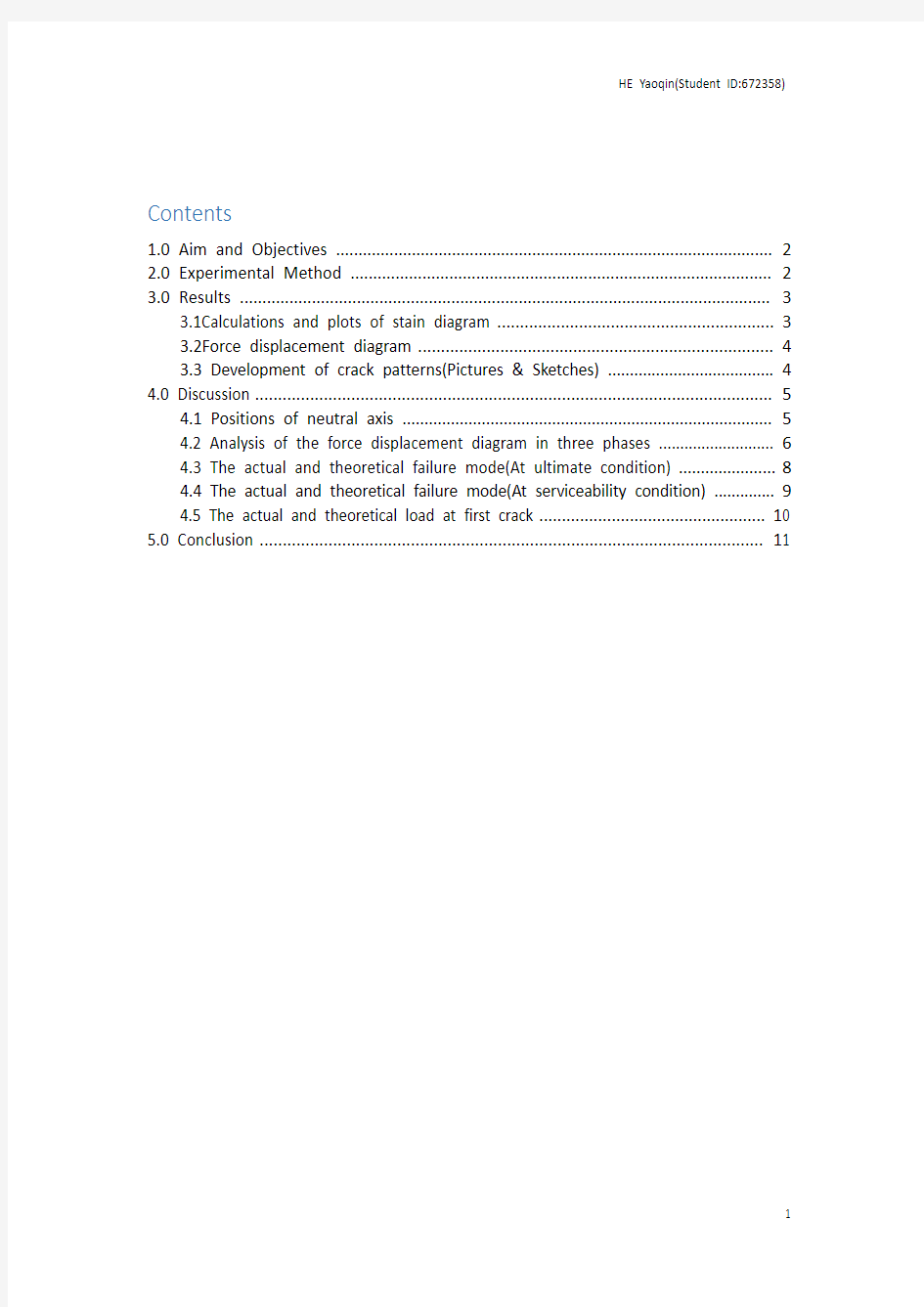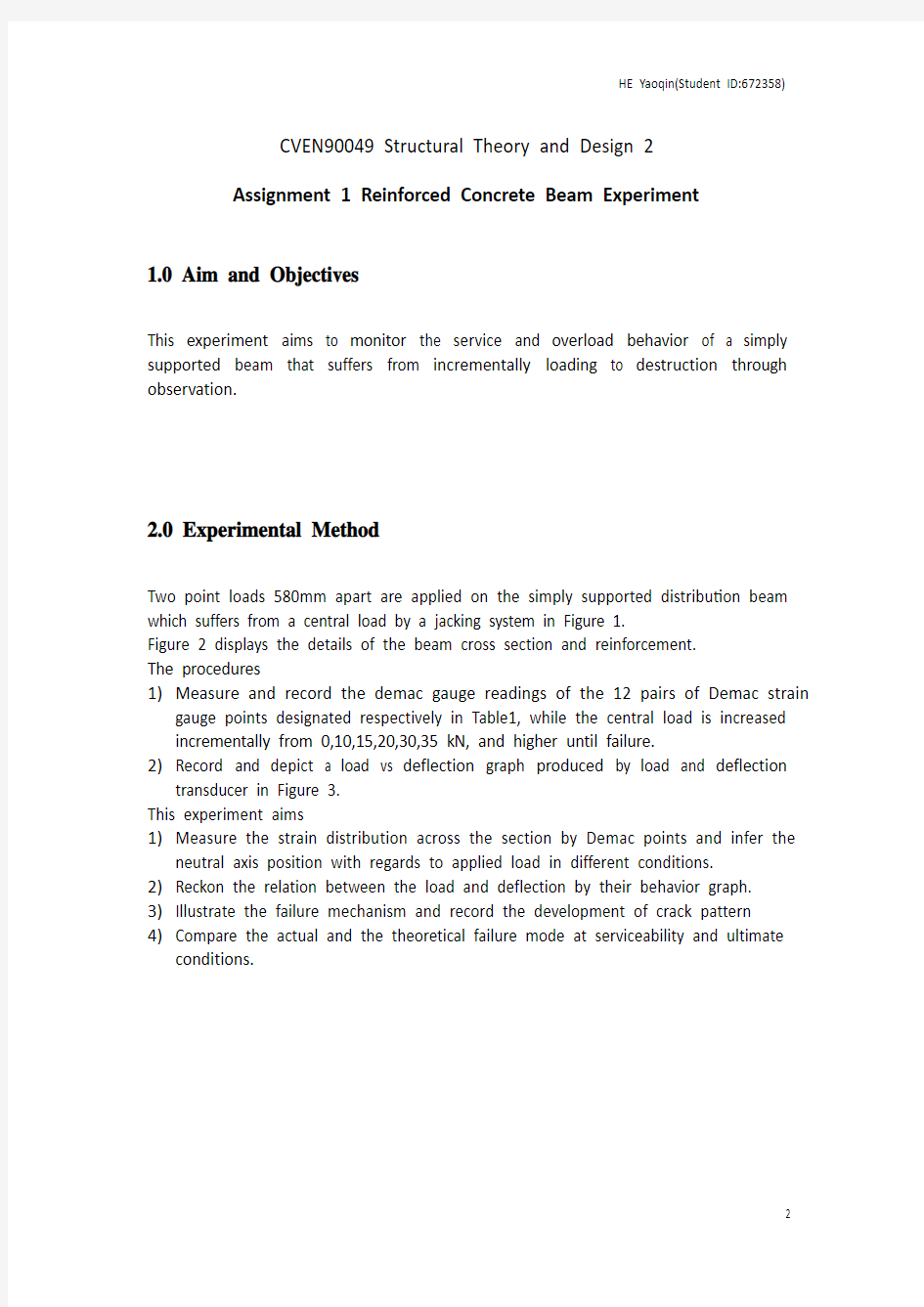

Contents
1.0 Aim and Objectives (2)
2.0 Experimental Method (2)
3.0 Results (3)
3.1Calculations and plots of stain diagram (3)
3.2Force displacement diagram (4)
3.3 Development of crack patterns(Pictures & Sketches) (4)
4.0 Discussion (5)
4.1 Positions of neutral axis (5)
4.2 Analysis of the force displacement diagram in three phases (6)
4.3 The actual and theoretical failure mode(At ultimate condition) (8)
4.4 The actual and theoretical failure mode(At serviceability condition) (9)
4.5 The actual and theoretical load at first crack (10)
5.0 Conclusion (11)
CVEN90049 Structural Theory and Design 2
Assignment 1 Reinforced Concrete Beam Experiment
1.0 Aim and Objectives
This experiment aims to monitor the service and overload behavior of a simply supported beam that suffers from incrementally loading to destruction through observation.
2.0 Experimental Method
Two point loads 580mm apart are applied on the simply supported distribution beam which suffers from a central load by a jacking system in Figure 1.
Figure 2 displays the details of the beam cross section and reinforcement.
The procedures
1)Measure and record the demac gauge readings of the 12 pairs of Demac strain
gauge points designated respectively in Table1, while the central load is increased incrementally from 0,10,15,20,30,35 kN, and higher until failure.
2)Record and depict a load vs deflection graph produced by load and deflection
transducer in Figure 3.
This experiment aims
1)Measure the strain distribution across the section by Demac points and infer the
neutral axis position with regards to applied load in different conditions.
2)Reckon the relation between the load and deflection by their behavior graph.
3)Illustrate the failure mechanism and record the development of crack pattern
4)Compare the actual and the theoretical failure mode at serviceability and ultimate
conditions.
3.0 Results
3.1Calculations and plots of stain diagram
Depict the strain diagram with regards to incrementally loading based on the table1.
Figure 1: Load=10kN
Figure 2: Load=15kN
3.2Force displacement diagram
The sketch of the simply supported beam
Bending moment diagram of the beam
M=P*1.08/2=0.54P(kN*m)
3.3 Development of crack patterns(Pictures & Sketches)
Phase1: No-crack phase Phase1a: The end of no-crack phase
Figure 5: Load=37kN
Figure 6: Load=40.5kN
Figure 7: The sketch of the simply supported beam
Figure 8: Bending moment diagram of the beam
Phase2: First-crack phase
Phase3: Failure phase
Phase3a: Ultimate phase
4.0 Discussion
4.1 Positions of neutral axis
Figure 11: First-crack phase
Figure 12: Failure phase
Figure 13: Ultimate phase
Table 2: Neutral axis position
As the data shown in the table 2 above, the neutral axis position keeps shifting up with regards to the incrementally loading.
And the force displacement diagram and the screenshots of the experiment video during the three phases(No-crack phase, First-crack phase, Failure phase) indicate that tensile area crack of the mid-span extends upward with the increasing central loading, causing the upward of the neutral axis.
4.2 Analysis of the force displacement diagram in three phases
(The load –deflection behavior and description of the failure mechanism)
Phase 1: No-crack Phase
When the loading is small, the shape of the cross section maintains a plane.
The Value ofσc(concrete stress) and σs(steel stress) are small, keeping liner relation as their elastic transformations. And the load and deflection present a liner relation.
In this phase, the bottom tensile concrete and tensile steel bear the tension together.
Phase 1a: The end of no-crack phase
At the end of phase1, the bottom concrete is going to crack when its tensile stress nearly reaches ft(concrete tensile strength) with increasing load.The graph of tensile stress of bottom concrete is trapezoidal while the graph of compressive stress of top concrete is still triangle.
Phase 2: First-crack Phase
When the loading keeps increasing, the beam occurs first crack as the marginal tensile strain of the bottom concrete exceeds tensile limit of deformation. The tensile concrete will not bear the tension any more, causing the tensile strain of the steel rise rapidly.
The crack extends and neutral axis moves upward with increasing load while the tensile strain of the steel and the strain of compressed concrete keep rising during this phase. And the load and deflection still remain a liner relation but deflection increases faster than that in phase 1.
Phase3: Failure Phase
The stress of tensile steel keeps growing and finally reaches fy(yield strength) while the loading continues to increase. At the beginning of this phase, the strain of tensile steel rise dramatically but stress remains fy, resulting in the drastic upward of the crack and the neutral axis. Hence, compressive zone area of the concrete decreases and the graph of that changes into curve shape.
Phase 3a: Ultimate Phase
At the end of phase3, the top concrete crushes when the stain of compressive concrete reaches εcu (ultimate compressive strain) and the graph of compressive zone area assumes to be rectangle in the ultimate calculation.
After the load reaching the failure load, the deflection increases rapidly with regards to the increasing load as the drastic upward crack of the beam. 4.3 The actual and theoretical failure mode(at ultimate condition) Theoretical Failure Load
Check the ultimate shear force fcmi=
812
π
0.1524
=45.95MPa
Using linear interpolation: f’c=40+
45.95?4353?43
*10=42.95MPa
Vu=Vuc+Vus
Vuc=β1β2β3b v d 0f′c 1(Ast b
v d 0
)1
3
β1=1.1(1.6-d/1000)1.47>0.8 β2=1 as N=0 β3=1
As=226mm 2, b=150mm d=268mm
Vuc=1.47*1*1*150*268*42.951(226
150?268)1=36.79kN
Vus=(Asv f sv.f d/s)*cot θv
Make an assumption cot θv =1 via AS 8.2.10 where have a specific justification Asv=2*π?
624
=56.52mm 2
Fsv=250MPa Vus=(
56.52?250?268
200
)?1=18.93kN
Vu=36.79+18.93=55.72kN V=P/2 Hence,P(ultimate)<111.44kN Figure 14: Shear force diagram Figure 15: Equivalent stress Table 3: AS3600-2009 Check the ultimate moment (Ignore fy=400Mpa , Mu=226?400?268?(1?226?400 1.7?150?268?4 2.95) =23.48kN*m Hence, P(ultimate)=23.48/0.54=43.48kN Measured Failure Load during experiment When load is approximately 44kN, the crack reaches the height of the first gauge point in the midspan of the beam. As the calculation shown above, this beam is flexural failure, the theoretical load approximately equals to the actual experimental load. 4.4 The actual and theoretical failure mode(At serviceability condition) Theoretical Failure Load Using l/500 that Prof. John Wilson mentioned as the value of serviceability limit to calculate the relevant load. ?=∫ ∑(Ω1?y1+Ω2?y2+Ω3?y3)EI = 1080?540P?0.5?685?1.081.37?2 3?2+290?540P?(685?1.08 1.37+685)?0.5?2 EI = P?4.02?108 EI =l 500=5.48mm Simplified Ief(AS3600,2009) Figure 16: Diagram multiplication method β=150 150=1 p=226 150?268=5.62*10?3>3.58*10?3 Ief=[(5-0.04*42.95)*5.62*10?3+0.002]*150*2683=0.59*108mm 4 <2.89*108mm 4 Ec=(p 1.5)?(0.024√f cmi +0.12) w?en f cmi >40MPa =(24001.5)?(0.024√45.95+0.12)=33237 N/mm 2 Hence, P=26.73kN Actual Failure Load As shown in the Load deflection relationship (Figure 3), when the deflection equals 5.48mm, the calculation of corresponding load could be seen below: Pactual=30+5*5.48?4.4 7.2?4.4=31.93kN As the calculation shown above, the theoretical load is smaller than the actual experimental load as the conservative consideration. 4.5 The actual and theoretical load at first crack Theoretical First Crack Load At the end of the phase 1, the beam appears the first crack when the stress of bottom tensile concrete reaches f ’c t(tensile strength of concrete). Table 4: Modulus of elasticity(AS3600-2009) Figure 17: Load deflection relationship Mcr/Z=f’ct -σcs f’c t=0.6√′c =0.6*√42.95=3.93MPa Z=b D 2/6= 150?3002 6 =2.25*106mm 3 As concrete shrinkage is a long term effect, this experiment is obviously completed over a very short time period, σcs is ignored (σcs =0) M cr=f’ct*Z=3.93*2.25*106=8.85kN*m Pcr=8.85/0.54=16.39kN Measured First Crack Load during experiment First crack occurs at approximately 14kN load 5.0 Conclusion This experiment focus on the regulations of the strain and stress of the reinforced concrete beam with the incrementally bending moment(Flexural failure).The neutral axis keeps upward when the crack of the mid-span extends with the increasing central loading. After the load reaching the failure load, the deflection increases rapidly with regards to the increasing load as the drastic upward crack of the beam, which means the ductility of the reinforced concrete beam is good. Figure 18: Stress diagram of cracking moment